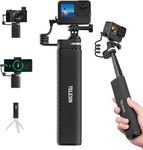Buying Guide for the Best Selfie Sticks
Choosing the right selfie stick can make a big difference in how easy and enjoyable it is to take photos or videos of yourself, friends, or surroundings. The best selfie stick for you depends on how you plan to use it—whether for travel, vlogging, group photos, or just casual selfies. It's important to consider how portable you need it to be, how stable it feels, and what devices you want to use it with. By understanding the key features, you can find a selfie stick that fits your needs and helps you capture great moments.Length (Extended and Collapsed)The length of a selfie stick refers to how far it can extend and how compact it is when folded. A longer extension lets you fit more people or background into your shot, while a shorter, more compact stick is easier to carry around. Typically, selfie sticks can extend anywhere from about 20 inches to over 40 inches. If you want wide group shots or scenic backgrounds, a longer stick is helpful. If you prefer portability and quick use, a shorter stick may be better. Think about how much reach you need and how much space you have in your bag or pocket.
CompatibilityCompatibility means which devices the selfie stick can hold and connect to. Some sticks are designed for smartphones only, while others can hold small cameras or action cams. Check the clamp size and the type of connection (Bluetooth, wired, or manual shutter). If you use a large phone or plan to switch between devices, make sure the stick can securely hold them. Always check the product details to ensure your device will fit and work with the stick.
Connection TypeSelfie sticks can connect to your phone or camera in different ways: Bluetooth, wired (with a cable), or no connection (using a timer or remote). Bluetooth sticks let you take photos by pressing a button on the handle, which is convenient and wireless. Wired sticks plug into your phone’s headphone jack and work with a button press, but not all phones have this port. Some sticks don’t connect at all and require you to use your device’s timer or a separate remote. Choose the connection type that matches your device and your preference for convenience.
Build Quality and MaterialBuild quality refers to how sturdy and durable the selfie stick is, and the material it’s made from (like aluminum, stainless steel, or plastic). A well-built stick feels solid and can support your device without wobbling. Metal sticks are usually stronger and last longer, while plastic ones are lighter but may not be as durable. If you plan to use the stick often or with heavier devices, look for a sturdy build. For occasional or light use, a lighter stick may be enough.
Grip and Handle ComfortThe grip and handle comfort affect how easy and pleasant the selfie stick is to hold, especially for longer periods. Some handles have rubber or foam padding for a better grip and less hand fatigue. If you’ll be holding the stick for a while, or using it in hot or wet conditions, a comfortable, non-slip handle is important. Try to find a stick that feels good in your hand and won’t slip easily.
Rotation and Angle AdjustmentRotation and angle adjustment refer to how much you can tilt or rotate the phone holder to get the best shot. Some selfie sticks let you adjust the angle up and down, or even rotate the device 360 degrees. This flexibility helps you find the perfect angle for selfies, group shots, or creative photos. If you want more control over your shots, look for a stick with good angle adjustment options.
Tripod FunctionalitySome selfie sticks can also be used as tripods, letting you set them on a surface for hands-free photos or videos. This is useful for group shots, vlogging, or video calls. If you want to take stable photos without holding the stick, or need to record yourself from a distance, consider a model with built-in tripod legs. If you only plan to use the stick for quick selfies, this feature may not be necessary.

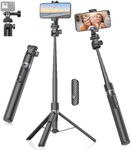





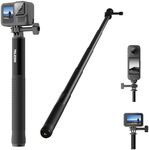
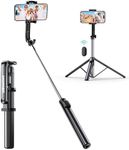
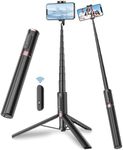



![andobil MagStick Selfie Stick Tripod Compatible with MagSafe [Redefined Phone Tripod] 63.5" Extendable Magnetic Cell Phone Tripod Stand with Wireless Remote for iPhone 16 15 14 13 12 & All Phones](https://images-proxy.bestreviews.guide/X9rmQLiifvcBnaqtebUtOKvGopw=/0x150/https://m.media-amazon.com/images/I/41HyEalux9L._AC_CX679_.jpg)
